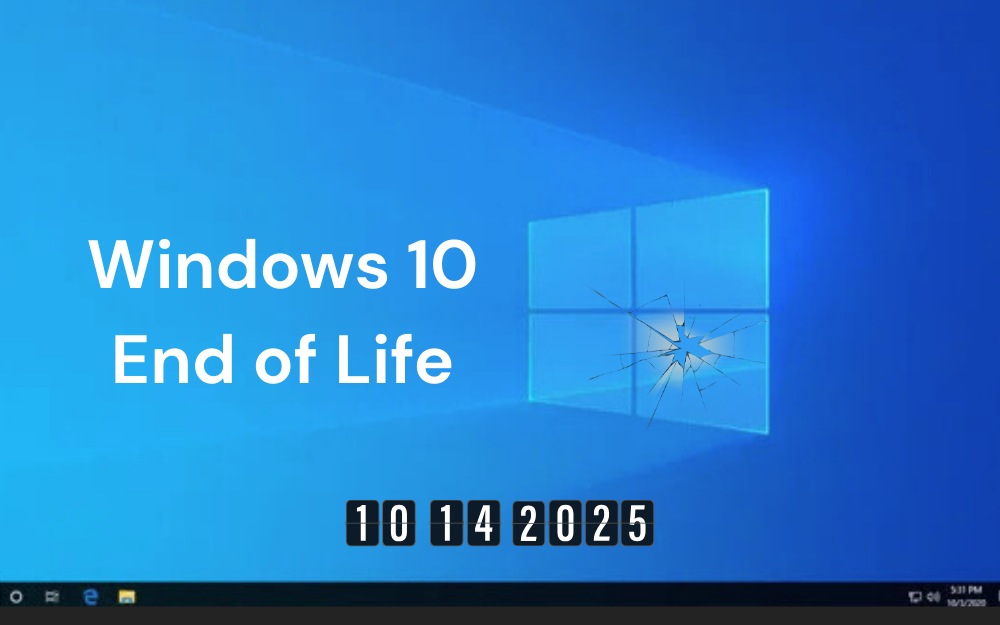
Mark your calendars for October 14, 2025 – the official end of life for Windows 10. After this date, Microsoft will no longer provide security updates, bug fixes, or technical support for Windows 10. As a business owner, this might sound like just another update, but it’s far more significant than you may realize. What happens to your business applications and productivity tools once Windows 10 support is gone?
If you’re still using Windows 10 after the cutoff, it’s not just the operating system at risk – your critical applications are too. Here’s what you need to know.
1. No More Security Updates = Major Vulnerabilities
Without regular security patches, any vulnerabilities discovered after October 14, 2025, will remain unaddressed, putting both your operating system and business applications at risk.
What This Means for Your Applications:
- Higher Risk of Data Breaches: Without security patches, your applications become easy targets for cyberattacks, including hacking attempts, ransomware, and data breaches.
- Compliance Issues: If your business operates in a regulated industry (healthcare, finance, etc.), running unsupported software could lead to compliance violations, hefty fines, and even reputational damage.
- Productivity Disruptions: A cyberattack could bring your entire business to a halt, resulting in lost revenue and operational downtime.
2. No More Feature Updates = Compatibility Issues Inevitable
As software vendors continue releasing new updates, they’ll stop supporting Windows 10. Eventually, your business applications may no longer be compatible with the outdated OS.
Here’s What You Might Face:
- Frequent Crashes and Glitches: Applications may become unstable, crash often, or fail to launch altogether, causing frustration and lost productivity.
- Missing Out on New Features: Many features and functionalities will only be available on supported operating systems like Windows 11. If you’re not upgrading, your team might miss out on key improvements.
- Security Gaps: New application updates often include security patches. Running on an unsupported OS means you won’t receive the latest security features, increasing your exposure to cyberattacks.
3. No More Technical Support
As Windows 10 reaches its end, not only will Microsoft stop providing support, but third-party software vendors will too.
The Consequences of This:
- No Technical Support: Software vendors will halt support for applications running on Windows 10, making it difficult to get assistance if something goes wrong.
- Integration Issues with New Tools: Modern tools will be designed for Windows 11 or beyond, making it hard to integrate new applications with your old system.
- Limited Hardware Compatibility: New hardware may not have drivers compatible with Windows 10, preventing you from upgrading or expanding your tech setup.
4. Performance and Productivity Will Suffer
As new, more advanced applications are developed, they’re optimized to run on modern operating systems. Windows 10 will increasingly struggle to keep up.
How This Affects Your Business:
- Slower Performance: Older systems can’t handle today’s advanced apps, leading to slower performance and a drop in employee productivity.
- Increased Downtime: More crashes, glitches, and system failures will lead to costly downtime.
- Higher Maintenance Costs: Running legacy systems requires more IT resources, which means higher maintenance costs and fewer dollars available for innovation.
What Should You Do?
To ensure your business remains secure, productive, and compliant after Windows 10 support ends, here are the steps we recommend:
- Back Up Your Data: Don’t risk losing valuable business information during the upgrade process.
- Upgrade to Windows 11 or Replace Your Computer: Evaluate if your current devices can support Windows 11 or if new hardware is needed.
- Check Compatibility: Use Microsoft’s PC Health Check tool to ensure your devices meet the requirements for Windows 11.
- Budget for Upgrades: If your devices can’t run Windows 11, plan for new hardware to avoid downtime.
- Partner with a Trusted IT Provider: Work with experts who can guide you through the upgrade process, ensuring minimal disruption.
- Implement Security Measures: Protect your data during the transition with appropriate security protocols.
Don’t Wait Until It’s Too Late
The end of Windows 10 support is fast approaching. Waiting until the last minute to act could leave your business exposed to cyberthreats, compliance risks, and productivity disruptions. Take action now to safeguard your applications and ensure business continuity.
Start with a FREE Network Assessment to evaluate your current IT setup, identify application dependencies, and create a seamless transition plan. Our team is here to ensure your business stays secure, efficient, and ready for the future.
Click here to schedule your FREE Network Assessment today!
To get started, call our office at 909-654-6444 or click here to schedule a consultation.